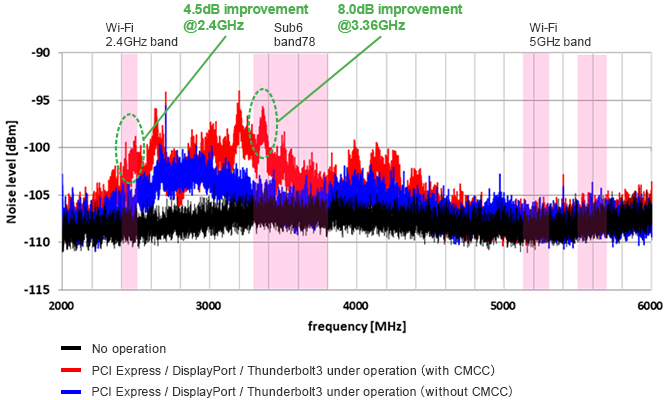Noise suppression technologies/case study introduction (Consumer)
Noise Suppression for USB4 (3)
INDEX
- USB4 Standard and Its Adoption
- Integration of USB and Thunderbolt
- Specifications and Comparison of Thunderbolt 3 and USB4
- Anticipated Noise Issues with USB
- Noise Suppression Measures for USB4
- Radiated Noise Measurement
- Measurement of radiated noise
- Intrasystem EMC: Overview of DUT (Thunderbolt 3 Compatible Add-in Card)
- Intrasystem EMC: Assessment of Impact on Wi-Fi Reception Sensitivity
- Intrasystem EMC: Measurement Results of Wi-Fi Reception Sensitivity (No Noise Suppression Measures)
- Intrasystem EMC: Assessment of Noise Entering the Antenna
- Intrasystem EMC: Measurement Results for Noise Entering the Antenna (No Noise Suppression Measures)
- Intrasystem EMC: Measurement of Nearfield noise (No Noise Suppression Measures)
- Intrasystem EMC: Noise Suppression Component Insertion Location
- Intrasystem EMC: Measurement Results of Reception Sensitivity (After Implementation of Noise Suppression Measures)
- Intrasystem EMC: Measurement Results for Noise Entering the Antenna (After Implementation of Noise Suppression Measures)
- Signal Waveform Check: Eye Pattern Measurement Procedure
- Signal Waveform Check: Eye Pattern Measurement
- Conclusion
10. Intrasystem EMC: Measurement Results of Wi-Fi Reception Sensitivity (No Noise Suppression Measures)
Example of Wi-Fi Reception Sensitivity Assessment
We examined the degree of impact on the Wi-Fi reception sensitivity by USB4 operation.
When various types of data communication were performed, the Wi-Fi (2.4 GHz band) reception sensitivity level dropped by about 3 dB. This was likely due to interference with the antenna by noise generated during communication.
In this DUT, a drop in reception sensitivity in the 5 GHz band was not found.
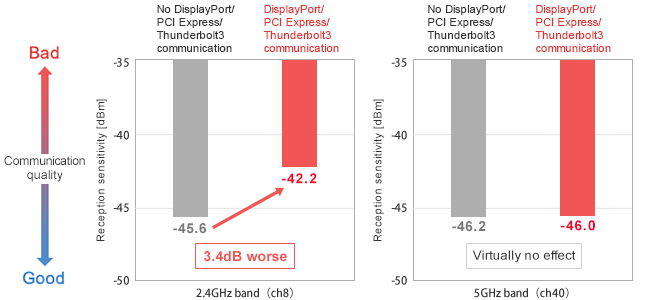
11. Intrasystem EMC: Assessment of Noise Entering the Antenna
Example of Assessment for Noise Entering Antenna
Next, we verified the level of noise entering the nearby antenna.
This assessment also used a distance of about 5 cm between the differential signal line and antenna.
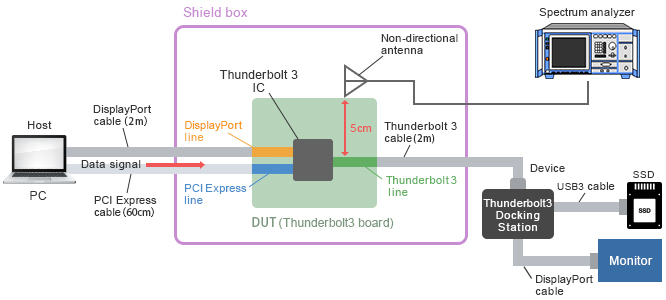
- Configuration
A Thunderbolt 3 add-in card was used as the host, and a Thunderbolt 3 docking station was used as the device.
A non-directional antenna was placed at a location that was 5 cm away from the Thunderbolt 3 signal wire on the add-in card board, and the noise radiating from the add-in card board was observed from the non-directional antenna.
During signal communication, PCI Express, DisplayPort, and Thunderbolt 3 signals are flowing simultaneously on the add-in card.
12. Intrasystem EMC: Measurement Results for Noise Entering the Antenna (No Noise Suppression Measures)
Measurement results
We found that broadband noise occurred due to DisplayPort, PCI Express, and Thunderbolt 3 communication in the 2 to 4.5 GHz range, and this noise entered the wireless antenna.
In particular, noise occurred in the Wi-Fi communication band (2.4 GHz) and sub-6 communication band (3.3 GHz), and this noise needs to be suppressed in order to stabilize communication.
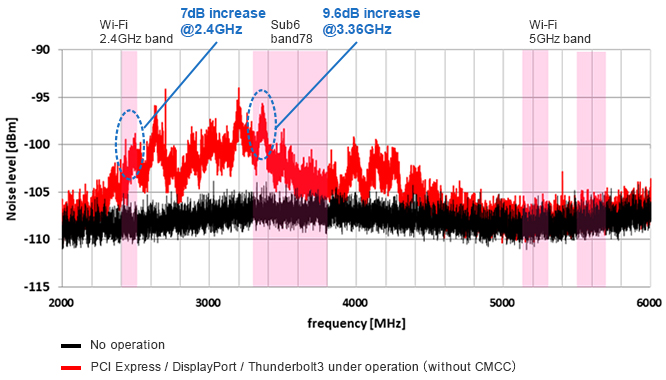
13. Intrasystem EMC: Measurement of Nearfield noise (No Noise Suppression Measures)
Measurement results
To identify the locations where noise occurred, the board was measured using an EMC tester capable of mapping the magnetic near field.
By performing various types of communication, broadband noise was propagated on the Thunderbolt 3 TX signal line, PCI Express Gen3 TX signal line, and DisplayPort signal line on the add-in card board.
It is thought that this broadband noise radiates in the space from the signal line and enters the wireless antenna.
Consequently, this results in drops in Wi-Fi reception sensitivity and sub-6 reception sensitivity.
This issue is also expected to occur in USB4, which has virtually the same electrical specifications as Thunderbolt 3.
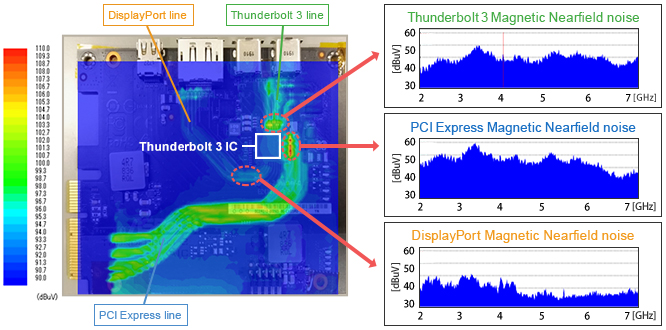
14. Intrasystem EMC: Noise Suppression Component Insertion Location
From previous assessments, we found that broadband noise radiating from the PCI Express, DisplayPort, and Thunderbolt 3 signal lines during Thunderbolt 3 communication resulted in reduced sensitivity in wireless communication.
In response, CMCCs (NFG0QHB372) were installed on the signal lines, which were the conduction paths of the noise, for suppressing noise radiating from the wires.
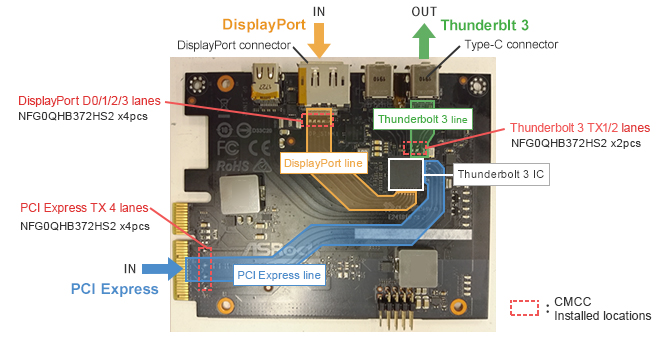
15. Intrasystem EMC: Measurement Results of Reception Sensitivity (After Implementation of Noise Suppression Measures)
Measurement results
Installing CMCCs (NFG0QHB372) on the signal lines resulted in an improvement of 3.0 dB in Wi-Fi (2.4 GHz) reception sensitivity during PCI Express, DisplayPort, and Thunderbolt 3 communication compared to usage without CMCCs.
16. Intrasystem EMC: Measurement Results for Noise Entering the Antenna (After Implementation of Noise Suppression Measures)
Measurement results
The noise entering the antenna was reduced by up to 8 dB.
The frequency of the entered noise must be used to select a component with specifications capable of suppressing noise in the 2.4 GHz to 5 GHz range.
